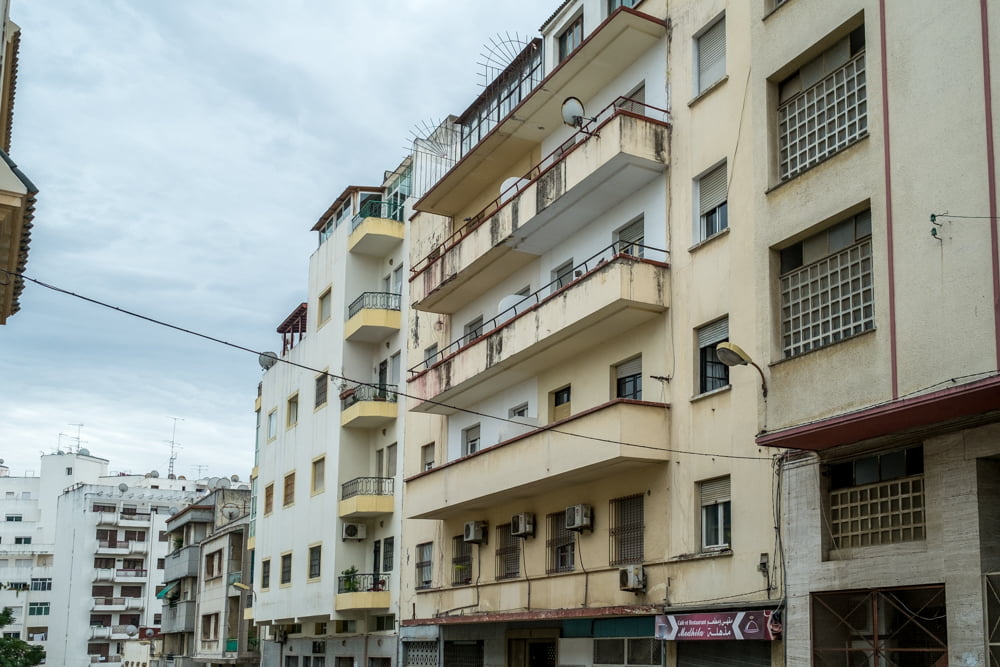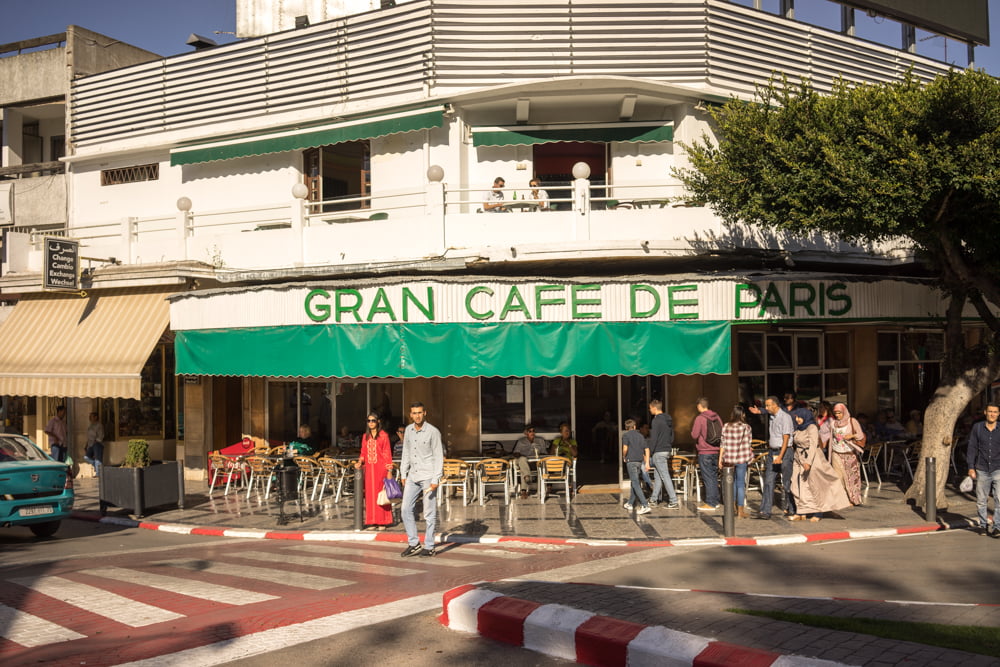I made the journey to Interzone from Tarifa across the 11 mile stretch of Atlantic where, in the distance, the Rif mountains stood in a coruscating haze of a bright September day. Interzone is an area where sea, ocean and cultures collide.
Tangier was an International Zone from 1912 to 1956 and became the destination for many European and American spies, writers, artists and musicians. It enjoyed a reputation for hedonism where any pleasure was readily available. Indeed author William S. Burroughs who lived for long spells in Tangier, wrote, “Tangier is one of the few places left in the world where, so long as you don’t proceed to robbery, violence, or some form of crude, antisocial behaviour, you can do exactly what you want.”
Linking mental images with the considerable literature, music and art generated here requires little effort. The writers who did spend time in Tangier often had lives spent in conflict with authorities. Burroughs himself accidentally killed his wife in a shooting incident, Jean Genet, characterised by David Bowie in his 1972 hit Jean Genie, spent time in prison in Paris for theft and sexual crimes (gay sex was still illegal). Allan Ginsberg, Jack Kerouac, Tennessee Williams, and more shared recurring themes of homosexuality, substance dependency and sometimes poor emotional health. Despite the undoubted creativity of these artists their behaviours suggest turbulent personalities escaping the fetters of their own countries where their proclivities and dependencies were firmly suppressed.
Considerable numbers of the most interesting associations occurred around bars and hotels, of which many entered the stories of legends. The terraces of Cafe Hafa dramatically overlook the Bay of Tangier and most, if not all, visitors to Interzone spent time here where the Cafe Hafa special, mint tea mixed with kif, is apparently still available. In the Medina, Cafe Baba has photographs of the Rolling Stones and Keith Richards smoking a kif pipe next to a photograph of Kofi Annan, the former Secretary-General to the United Nations. Its owner Abdelghani remembers meeting these artists as a boy working for his father in the cafe. The grimy windows of Cafe Baba overlook the opulent palace of Sidi Hosni where wealthy Woolworth’s heiress Barbara Hutton held many parties on the terraces, married her 7th husband and persuaded officials from the local authorities to widen the gates of the medina to allow her Rolls Royce to more easily enter. The Gran Cafe de Paris, a favourite haunt of Genet and Francis Bacon and Truman Capote, still has a gallic flair with a strange ceramic palm inside. It is no longer possible to conduct intellectual and artistic conversation on the terraces outside; the modern roundabout there is now one of the busiest in Tangier. Dean’s Bar, where everybody who was anybody used to frequent and whose eponymous owner died from a heroin overdose in 1963, is now forlornly closed, with a red sign saying Export 33 bringing its grey facade to life.

American Legation where a museum dedicated to Paul Bowles exists. Also McBey’s portrait of a servant girl called Zohra can be seen.
In the Petit Socco, or small square, the cafes Fuentes, Central and Tingis, where many brothels could once be found, entertained many artists over the years. It was here that Burroughs would look for male consorts and Tennessee Williams wrote Camino Real. The Grand Socco, or large square, is now called Place du Grand 9th Avril, the date of Morocco’s independence, but was once a bustling grain market where Cherifa, the female lover of American author Jane Bowles, used to work. Paul Bowles, Jane’s famous author and composer husband was convinced that Cherifa had put a spell on Jane and later found packets of pubic hair, finger nails, and menstrual blood that Cherifa had planted in the apartment that the two shared. They were all to later move into adjacent flats at the Edificio San Francisco, a then modern block of flats opposite the Spanish Consulate, where Jane lived between the two flats. Eventually Jane gave the deeds of her property to Cherifa before eventually dying in a hospital in Malaga.
Burrough’s famed novel Naked Lunch details his own heroin addiction through a series of vignettes mostly framed within a conceptual, imaginary state he called Interzone, a reference to Tangier as an abbreviation of its International Zone status. He wrote this mostly in the el Muniria Hotel, in the Spanish Quarter and close to the current Border Art Factory during periods of abstention. He had been known to spend months isolating himself in his room whilst under the worst influence of his addiction.
During these years the esteemed Moroccan writer Mohamed Choukri wrote 3 books describing his friendships with Paul Bowles, Tennessee Williams and Jean Genet. Illiterate until his early 20s Choukri decided to learn to write and read and went to school for the first time. His traumatic childhood was detailed in his autobiography For Bread Alone, a story he dictated to Paul Bowles, who translated the spoken Darija into written Arabic and when published in 1982 was censured in Morocco until 2003 due to the sexual content. A photograph of Choukri remains, complete with his trademark cigarette, as a momento above the table at the Restaurant el Dorado where he ate most evenings, close to the Roxy Cafe and his fourth storey flat. Choukri died in 2003.
Other artists who visited Tangier included Henri Matisse, Eugène Delacroix, Joan Miro, Francis Bacon and Edouard Degas. From the world of music Jimi Hendrix, the Rolling Stones and Graham Nash traveled there, the Stones famously in Keith Richard’s Bentley, nicknamed Blue Lena. Other visitors included Brion Gyson, James McBey, Jo Orton, Cecil Beaton, and Allan Sillitoe. Scottish artist James McBey painted a portrait of a servant girl called Zohra which has been called the Moroccan Mona Lisa, and can be seen hanging in the American Legation Museum.
Today most of the buildings remain and some memorabilia can be found, but time has passed. Some locals remember events from their childhood and the legends which have passed down. A shop owner in the rue Amrah directed me to where Paul Bowles once lived in a little house just south of the street and said, as a boy, he could remember Bowles. The American Legation Museum has several rooms devoted to memorabilia of Bowles, including his typewriter, though Bowles wrote most of his fiction longhand. Sometimes the butler dressed in red at the Grand Hotel Villa de France will show visitors room 35, where Matisse painted his famous Window at Tangier, better known a ‘Paysage vu d’une fenêtre’, overlooking the Kasbah, for just a few dirham’s tip.

Edificio San Francisco where Paul Bowles lived together with Cherifa, his wife’s lover, in adjacent apartments
Otherwise little survives from Interzone, other than the literature, art and music created by the geniuses who came and passed through. Few stayed, mostly notably Bowles, who died in the Italian Hospital aged 88 in 1999 after 50 years living in Tangier, but even his body has gone, flown back to the USA where he was buried in New York.
Only shadows, ghosts and fading photographs remain.
Many more fascinating details can be found in ‘Tangier: A Literary Guide for Travellers (Literary Guides for Travellers)’ by Josh Shoemake. Josh lives in Paris and Marrakesh and taught literature in Tangier, Morocco and was headmaster of The American School of Marrakesh.





